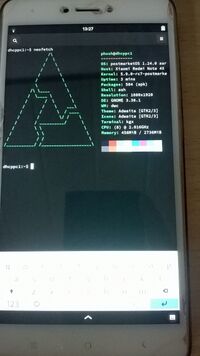Xiaomi Redmi Note 4 (xiaomi-mido)
Appearance
 Xiaomi Redmi Note 4 | |
| Manufacturer | Xiaomi |
|---|---|
| Name | Redmi Note 4 |
| Codename | xiaomi-mido |
| Released | 2017 |
| Hardware | |
| Chipset | Qualcomm Snapdragon 625 (MSM8953) |
| CPU | Octa-core 2 GHz Cortex-A53 |
| GPU | Adreno 506 |
| Display | 1080x1920 |
| Storage | 16 GB / 32 GB / 64 GB |
| Memory | 2 GB / 3 GB / 4 GB |
| Architecture | aarch64 |
| Software | |
| Original software | MIUI 9 |
| postmarketOS | |
| Category | testing |
| Pre-built images | no |
| Mainline | yes |
| Unixbench Whet/Dhry score | 3697.5 |
| Flashing |
Works |
|---|---|
| USB Networking |
Works |
| Internal storage |
No data |
| SD card |
No data |
| Battery |
Partial |
| Screen |
Works |
| Touchscreen |
Works |
| Multimedia | |
| 3D Acceleration |
Works |
| Audio |
Partial |
| Camera |
Partial |
| Camera Flash |
No data |
| Connectivity | |
| WiFi |
Works |
| Bluetooth |
Works |
| GPS |
Broken |
| NFC |
No data |
| Modem | |
| Calls |
Broken |
| SMS |
Broken |
| Mobile data |
Broken |
| Miscellaneous | |
| FDE |
No data |
| USB OTG |
No data |
| HDMI/DP |
No data |
| Sensors | |
| Accelerometer |
Broken |
| Magnetometer |
No data |
| Ambient Light |
No data |
| Proximity |
No data |
| Hall Effect |
No data |
| Haptics |
No data |
| Barometer |
No data |
Contributors
Maintainer(s)
Users owning this device
- 6yntar05 (Notes: Daily Driver)
- Bczeman
- Eldyj (Notes: Daily driver, 32gb, chinese display (damaged)&battery, black screen when booting PMOS, running Voltage OS)
- Gelzar2041 (Notes: 3/32, Screenless (Waiting for New LCD), from blackmarket)
- Gravitos (Notes: Only visual damage)
- Icenowy
- Jan64X
- Joel
- Kiciuk (Notes: Daily Driver-currently mainlining)
- Lassebq
- Lucid (Notes: Daily Driver)
- Marc0x (Notes: 2 , one with broken display)
- Marineboy1
- Mighty (Notes: Daily Driver)
- Overbafer1
- Qwertz (Notes: Ubuntu Touch/PMOS)
- Selfisekai
- Serg12344
- Shadowsvanish (Notes: Running postmarketOS (mainline kernel))
- Shipa (Notes: Hatsune Miku edition)
- Sliwkr
- Slwyts (Notes: 4GB RAM, 64GB Flash)
- Thedanilfez (Notes: PostmarketOS edge, sxmo)
What works
- Screen
- Touchscreen
- Wifi
- USB Net
- Sound
- Bluetooth
Device Notes
Display Panels
| LCD Vendor | IC Vendor | Supported? |
|---|---|---|
| BOE | Novatek NT35532 | Yes |
| Tianma | Novatek NT35596 | Yes |
| Tianma | otm1911 | Need testing |
| BOE | IlItek ili9885 | Need testing |
| EBBG(Foxconn) | Synaptics r63350 | Need testing |
Camera
| Camera Sensor | Package vendor | Supported? |
|---|---|---|
| Sony IMX258 | Ofilm/qtech/sunny | imx258.c in mainline - need testing |
| Samsung S5K3L8 | Ofilm/qtech/sunny | Not in mainline however there is some initial support. |
| Samsung S5K5E8 | Ofilm/qtech/sunny | No support for now |
| Omnivision ov13855 | Ofilm/qtech/sunny | No support for now |
Battery
| Battery Vendor | Supported? |
|---|---|
| Desay lisheng 4v4 | No |
| Sunwooda atl | No |
Sensors
All sensors are handled by remote processor and exposed via QMI, they all will work once proper driver lands in mainline.
How to enter flash mode
Press Power and Volume Down(fastboot mode)
Installation
- Install custom lk2nd (alternative bootloader that provides a standard fastboot interface). You need to compile it yourself.
- Follow the Installation guide
- If using recovery zip, boot into lk2nd and flash boot.img into lk2nd using
$ fastboot flash boot boot.img, then hit the power button to reboot
GPU bug workaround
At the time of writing, Freedreno ( the GPU driver ) has some bug. If you encounter any of this, try to create a file with export FD_MESA_DEBUG=nobin in /etc/profile.d/gpu-nobin.sh and reboot.